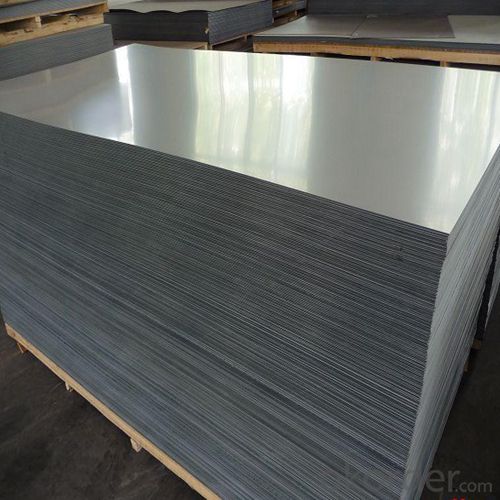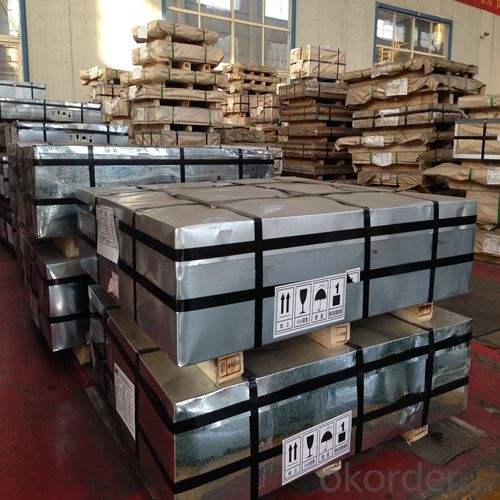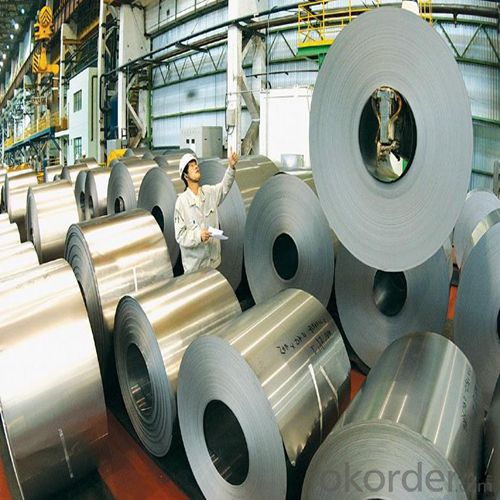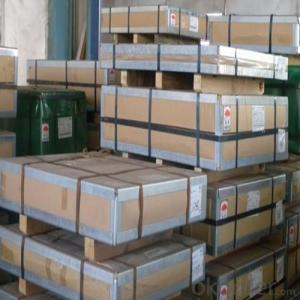Electrolytic Tinning Plate for Can Making
- Loading Port:
- Tianjin
- Payment Terms:
- TT OR LC
- Min Order Qty:
- 25 unit
- Supply Capability:
- 7000 unit/month
OKorder Service Pledge
OKorder Financial Service
You Might Also Like
1.Structure of Electrolytic Tinning Plate for Can Making Description
Electrolytic Tin Plate Coils and Sheets for Foods Metal Packaging, is one thin steel sheet with a coating of tin applied by electrolytic deposition. Tinplate made by this process is essentially a sandwich in which the central core is strip steel. This core is cleaned in a pickling solution and then fed through tanks containing electrolyte, where tin is deposited on both sides. As the strip passes between high-frequency electric induction coils, it is heated so that the tin coating melts and flows to form a lustrous coat.
2.Main Features of the Electrolytic Tinning Plate for Can Making
Appearance – Electrolytic Tin Plate is characterized by its beautiful metallic luster. Products with various kinds of surface roughness are produced by selecting the surface finish of the substrate steel sheet.
Paintability and printability – Electrolytic Tin Plates have excellent paintability and printability. Printing is beautifully finished using various lacquers and inks.
Formability and strength – Electrolytic Tin Plates have got very good formability and strength. By selecting a proper temper grade, appropriate formability is obtained for different applications as well as the required strength after forming.
Corrosion resistance – Tinplate has got good corrosion resistance. By selecting a proper coating weight, appropriate corrosion resistance is obtained against container contents. Coated items should meet 24 hour 5 % salt spray requirement.
Solderability and weldability – Electrolytic Tin Plates can be joined both by soldering or welding. These properties of tinplate are used for making various types of cans.
Hygienic – Tin coating provides good and non toxic barrier properties to protect food products from impurities, bacteria, moisture, light and odours.
Safe – Tinplate being low weight and high strength makes food cans easy to ship and transport.
Eco friendly – Tinplate offers 100 % recyclability.
Tin is not good for low temperature applications since it changes structure and loses adhesion when exposed to temperatures below – 40 deg C.
3.Electrolytic Tinning Plate for Can Making Images



4.Electrolytic Tinning Plate for Can Making Specification
Standard | ISO 11949 -1995, GB/T2520-2000,JIS G3303,ASTM A623, BS EN 10202
|
Material | MR,SPCC |
Thickness | 0.15mm - 0.50mm |
Width | 600mm -1150mm |
Temper | T1-T5 |
Annealing | BA & CA |
Coil Inner Diameter | 508mm |
Weight | 6-10 tons/coil 1~1.7 tons/sheets bundle |
Passivation | 311 |
Oil | DOS |
Surface | Finish,bright,stone,matte,silver |
5.FAQ of Electrolytic Tinning Plate for Can Making
- How are the Electrolytic Tin Plates specified?
The Electrolytic Tin Plates are specified as per the steel base, extent of tempering, the coating weight, annealing method and the surface finish.
- How many types there are for base steels?
The base steels are of three types: Type MR, L, D
-What your tinplate material is used for ?
Tinplate is widely used for the packaging of products. Such as food cans,
beverage cans, pet cans, closures, general line cans and so on.
- Q:How does tinplate perform in high humidity environments?
- Tinplate performs well in high humidity environments due to its corrosion resistance properties. The tin coating on the steel substrate acts as a barrier, preventing moisture from reaching the metal surface and causing corrosion. Therefore, tinplate is an excellent choice for packaging and other applications in high humidity conditions.
- Q:What are the main applications of tinplate in the jewelry industry?
- The main applications of tinplate in the jewelry industry include the production of tin-plated jewelry components such as clasps, findings, and beads. Tinplate is also utilized for decorative purposes, adding a shiny and lustrous finish to jewelry pieces.
- Q:What are the main differences between tinplate and tinplate laminates in terms of barrier properties?
- Tinplate and tinplate laminates differ in terms of their barrier properties. Tinplate, which is made of a single layer of tin-coated steel, offers good barrier properties against moisture and gases. It provides a reliable protective barrier for food and beverage packaging. On the other hand, tinplate laminates consist of tinplate combined with other materials, such as plastic or paper. These laminates can enhance the barrier properties of tinplate, offering additional protection against light, oxygen, and other external factors. The use of laminates allows for customized packaging solutions that cater to specific product requirements. Overall, tinplate laminates provide a higher level of barrier protection compared to plain tinplate.
- Q:How does tinplate perform in terms of resistance to UV radiation?
- Tinplate generally has poor resistance to UV radiation. Without proper protective coatings or treatments, tinplate is susceptible to degradation and discoloration when exposed to prolonged sunlight or UV radiation.
- Q:What are the transportation considerations for tinplate?
- Transportation considerations for tinplate include ensuring proper packaging and securing the tinplate to prevent damage during transit. Due to its susceptibility to corrosion, tinplate should be protected from moisture and extreme temperatures. Additionally, the weight and size of tinplate may impact the choice of transportation method and require careful handling to prevent accidents or injuries.
- Q:What are the main differences between tinplate and tin-free steel?
- Tinplate is a thin steel sheet that is coated with a layer of tin, while tin-free steel is a type of steel that does not have a tin coating. The main difference between the two lies in their corrosion resistance and price. Tinplate offers excellent corrosion resistance due to its tin coating, making it ideal for packaging materials, such as food cans. On the other hand, tin-free steel may have lower corrosion resistance but is more affordable and commonly used in applications where corrosion resistance is not a primary concern, such as automotive parts or construction materials.
- Q:What are the typical finishing options for tinplate products?
- The typical finishing options for tinplate products include tin plating, lacquering, lithography, embossing, and varnish coating.
- Q:How does tinplate perform in terms of insulation properties?
- Tinplate does not perform well in terms of insulation properties as it is a good conductor of heat and electricity.
- Q:What are the different ways to display tinplate containers?
- There are various ways to display tinplate containers, some of which include using shelving units or racks, utilizing countertop displays or stands, arranging them in window displays, or even using wall-mounted hooks or pegboards for a more creative presentation.
- Q:What are the advantages of using tinplate for HVAC components?
- There are several advantages to using tinplate for HVAC components. Firstly, tinplate is highly resistant to corrosion, making it suitable for applications in humid environments or those involving exposure to moisture. Secondly, tinplate offers excellent heat resistance, ensuring the durability and longevity of HVAC components even under high temperatures. Additionally, tinplate is lightweight, making it easier to handle and install, while still maintaining its strength and structural integrity. Lastly, tinplate is a cost-effective option, providing a balance between performance and affordability for HVAC systems.
1. Manufacturer Overview |
|
|---|---|
| Location | |
| Year Established | |
| Annual Output Value | |
| Main Markets | |
| Company Certifications | |
2. Manufacturer Certificates |
|
|---|---|
| a) Certification Name | |
| Range | |
| Reference | |
| Validity Period | |
3. Manufacturer Capability |
|
|---|---|
| a)Trade Capacity | |
| Nearest Port | |
| Export Percentage | |
| No.of Employees in Trade Department | |
| Language Spoken: | |
| b)Factory Information | |
| Factory Size: | |
| No. of Production Lines | |
| Contract Manufacturing | |
| Product Price Range | |
Send your message to us
Electrolytic Tinning Plate for Can Making
- Loading Port:
- Tianjin
- Payment Terms:
- TT OR LC
- Min Order Qty:
- 25 unit
- Supply Capability:
- 7000 unit/month
OKorder Service Pledge
OKorder Financial Service
Similar products
New products
Hot products
Related keywords



























